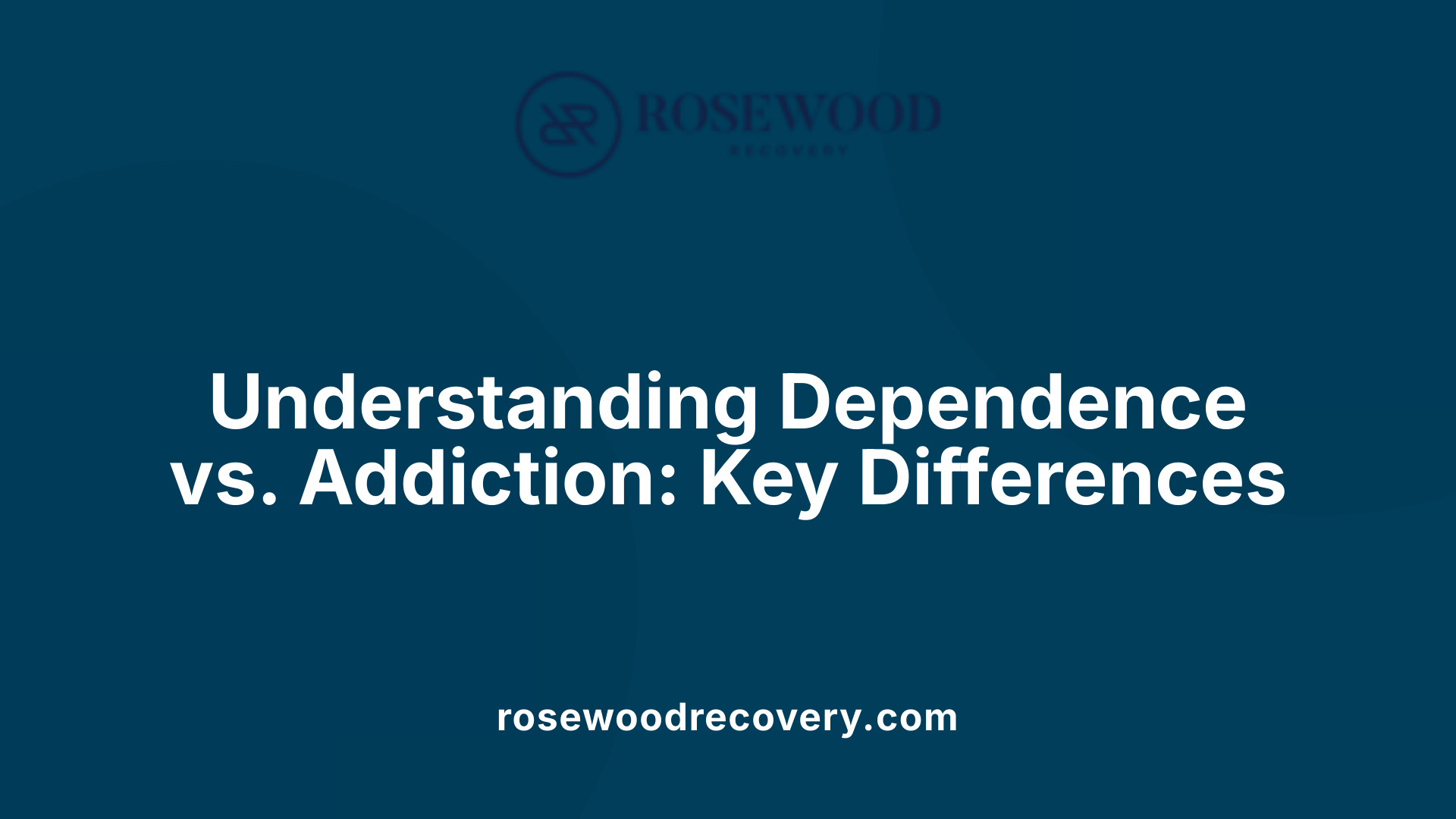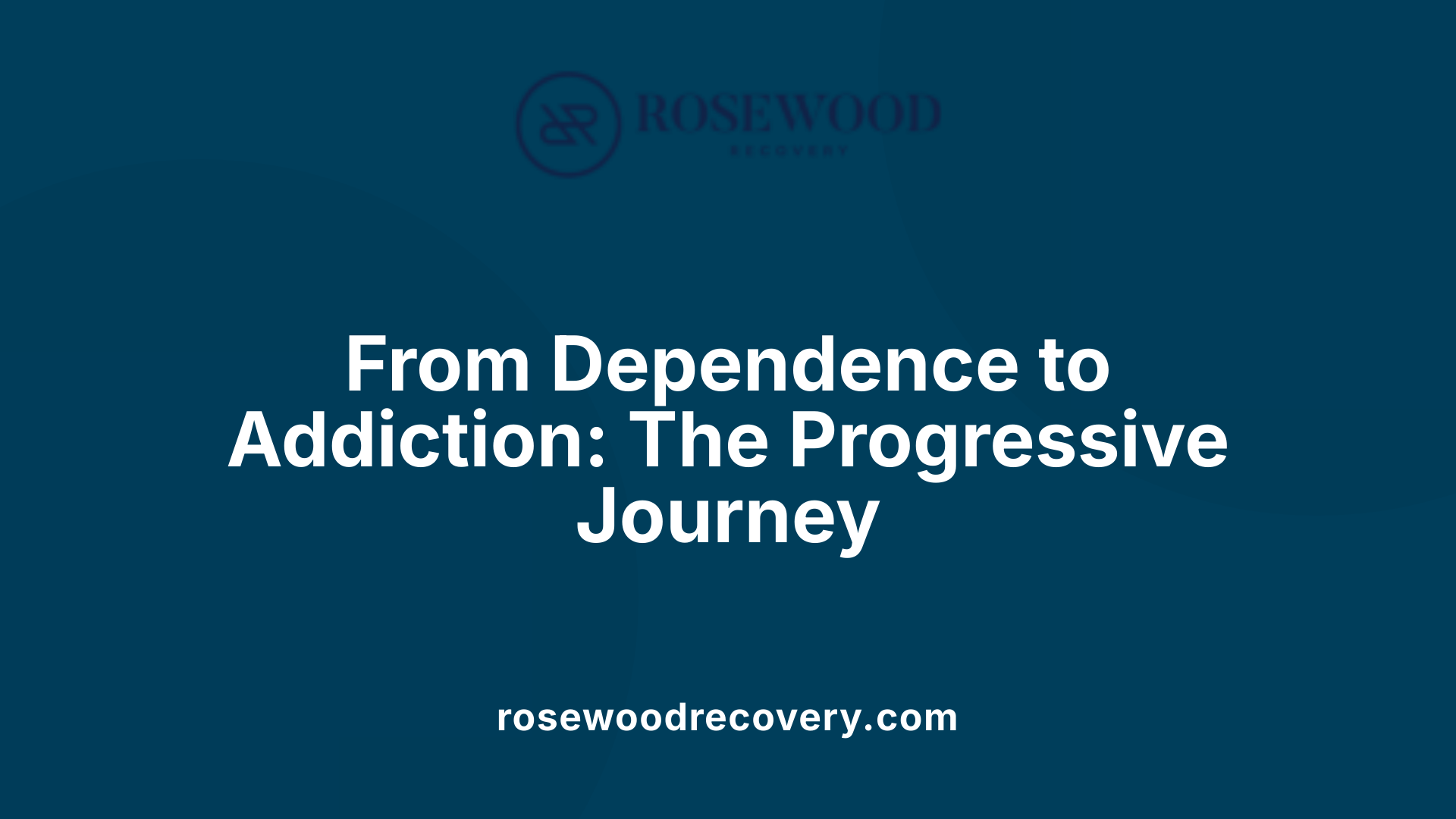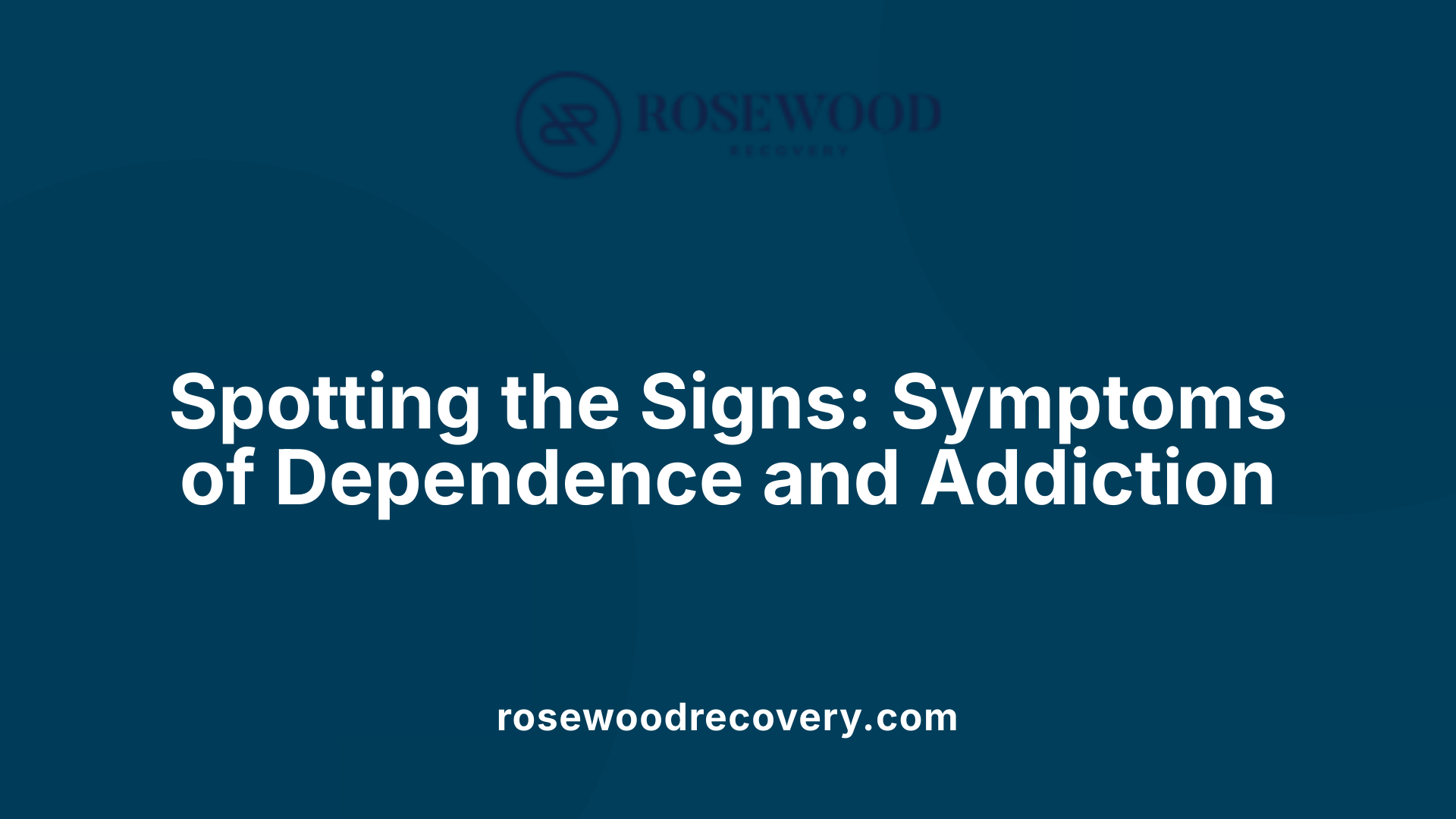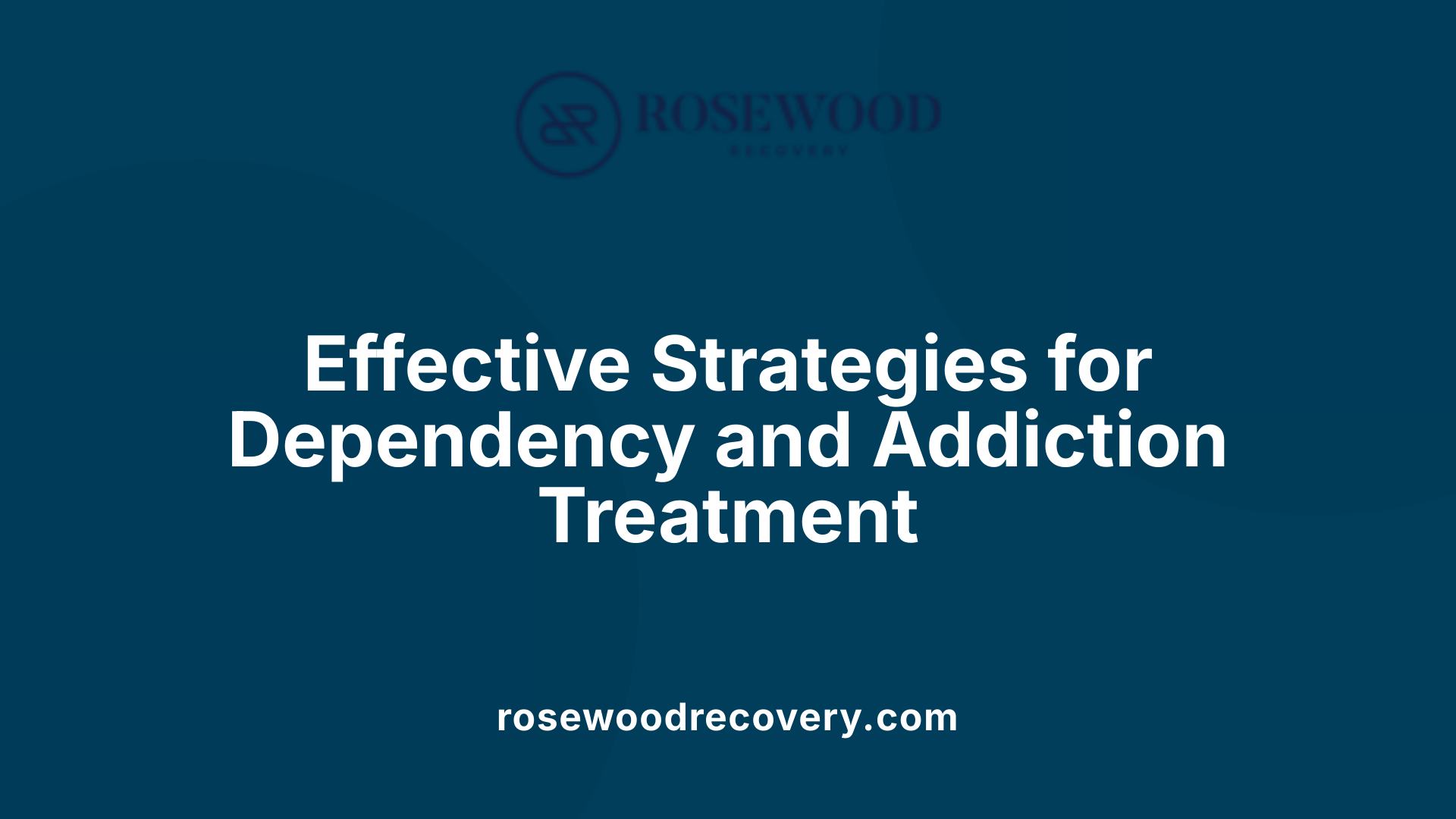Understanding Dependency and Addiction: Definitions and Key Differences
Dependence and addiction are terms often used interchangeably, but they describe distinct aspects of substance use disorders. Clarifying these differences is crucial for proper diagnosis, treatment, and reducing stigma. This article explores the definitions, neurological foundations, symptoms, and treatment options for both conditions, providing a comprehensive understanding of this complex subject.
Defining Dependence and Addiction

What is physical dependence?
Physical dependence describes a physiological state where the body adapts to a substance over time. This adaptation leads to tolerance—requiring higher doses to achieve the same effect—and withdrawal symptoms if the substance use stops abruptly. Symptoms include muscle aches, sweating, nausea, tremors, and psychological effects like anxiety or depression. Dependence can develop after long-term use of medications such as opioids, benzodiazepines, alcohol, or nicotine.
What does psychological dependence involve?
Psychological dependence, often called mental dependence, revolves around emotional and behavioral reliance on a substance. This includes cravings, preoccupation with drug thoughts, emotional responses to environmental cues or stress triggers, mood swings, and social withdrawal. It results from conditioned responses that reinforce addiction behaviors, which can persist even without physical withdrawal symptoms.
How do behavioral components of addiction manifest?
Addiction extends beyond physical dependence to encompass compulsive drug-seeking and use despite harmful consequences. Signs include risking relationships, neglecting responsibilities, engaging in risky behaviors to obtain the substance, and a loss of control over intake. Addiction is characterized by a persistent desire to use, high relapse rates, and difficulties in stopping despite clear negative impacts.
How has terminology changed over time?
Historically, terms like "dependence" and "addiction" have been used interchangeably. However, modern diagnostic manuals have refined this language. The DSM-IV distinguished between substance abuse and dependence, but the DSM-5 now categorizes these under "substance use disorder," which varies in severity—from mild to severe—based on specific criteria. This shift aims to better reflect the complex nature of these conditions.
Is alcoholism a dependency or an addiction?
Alcoholism, clinically known as alcohol use disorder (AUD), is best described as an addiction. It involves persistent drug-seeking behavior, cravings, loss of control, and relapse risk. While physical symptoms like withdrawal can indicate dependency, the core of AUD includes behavioral and psychological components, making it a multifaceted brain disorder. It necessitates comprehensive treatment addressing both physical dependence and addictive behaviors.
| Aspect | Dependence | Addiction | Difference |
|---|---|---|---|
| Physical vs. Behavioral | Primarily physiological | Both physical and psychological | Dependence involves physical symptoms; addiction involves behavior. |
| Severity and Impact | May not impair daily functioning | Impairs personal, social, and occupational life | Addiction generally more disruptive than dependence alone. |
| Treatment focus | Detoxification and tapering | Long-term behavioral therapy, medication, support | Treatment strategies differ for each condition. |
Understanding these distinctions helps in diagnosing and tailoring effective treatment strategies for individuals struggling with substance-related issues.
Physical and Psychological Dependence: A Closer Look
What are tolerance and withdrawal symptoms?
Physical dependence on a drug often leads to tolerance, where increasing doses are needed to achieve the same effect. Withdrawal symptoms can occur if the drug is suddenly reduced or stopped. These symptoms vary depending on the substance but commonly include muscle aches, restlessness, anxiety, sweating, nausea, and headaches. For example, opioids may cause muscle pain and irritability during withdrawal, while alcohol withdrawal can trigger tremors, seizures, and delirium. Recognizing these signs is important to manage dependence effectively.
Can you be dependent but not addicted?
Yes, it is possible to be dependent on a medication without being addicted to it. Dependence refers to physical changes in the body that produce withdrawal symptoms if the drug is stopped, but this does not necessarily involve cravings or loss of control. For example, medications like paroxetine and clonidine can cause dependence without leading to addiction, as individuals do not experience compulsive use or seek the drug despite negative consequences. Addiction, on the other hand, involves a psychological craving, a loss of control over drug use, and continued use despite harm, which can occur independently of physical dependence. It is important for clinicians to distinguish between dependence and addiction to provide appropriate treatment and avoid misdiagnosis that can lead to unnecessary stigma or inadequate care.
What is psychological dependence and how do cravings play a role?
Psychological dependence involves emotional and mental preoccupations with drug use. It is characterized by cravings, emotional responses to triggers, and behavioral changes. People may experience strong urges to consume substances, especially when exposed to environmental cues or stress. Cravings can persist long after physical withdrawal symptoms have subsided and are often a significant obstacle in recovery. These conditioned responses are driven by neurochemical alterations in the brain's reward pathways, increasing the likelihood of relapse.
How does long-term medication use influence dependence?
Long-term use of certain medications, like opioids or benzodiazepines, can lead to physical dependence, especially if used beyond recommended durations. Dependence may develop after six months or more of habitual use, even when prescribed for legitimate health reasons. Managing this type of dependence often involves gradual tapering or substitution under medical supervision to reduce withdrawal risks. It's important to note that dependence in this context does not automatically mean addiction, but careful monitoring is necessary to prevent escalation into addictive behaviors.
Neurological Changes and Their Impact
What is the difference between habit dependence and addiction?
Habit dependence involves automatic behaviors that are learned through repetition. These habits are generally harmless and are under conscious control, meaning individuals can choose to break or modify them without significant difficulty. Examples include brushing teeth or riding a bike.
In contrast, addiction is a chronic condition characterized by compulsive engagement in behaviors despite negative consequences. It involves substantial changes in brain circuitry, particularly within systems that regulate reward, motivation, and memory. As a result, individuals with addiction experience intense cravings, withdrawal symptoms, and a persistent drive to seek and use substances or engage in certain behaviors.
Addictions involve a significant rewiring of neural pathways, making it harder to change behaviors through willpower alone. These neural adaptations include altered reward pathways that produce a heightened response to substance-related cues and diminish the natural ability to derive pleasure from everyday activities.
While habits develop through neural reinforcement of repeated actions and tend to be manageable, addictions often require professional treatment because they interfere with normal functioning and involve physical and psychological dependence.
Habits may sometimes become problematic or evolve into addictive behaviors if they are reinforced with high rewards and start to impair daily life. However, the fundamental difference lies in the degree of neural change and the level of control individuals can exert over these behaviors.
In summary, habits are normal, manageable behaviors formed through neural reinforcement, while addiction involves chronic, uncontrollable behaviors driven by profound changes in brain structure and chemistry. Recognizing this distinction is crucial for effective diagnosis and treatment of substance use disorders.
Brain circuitry alteration in addiction | Reward pathways and dopamine | Neurogenetic factors influencing susceptibility | Progression from dependence to addiction
The Developmental Pathway: From Dependency to Addiction

What comes first, addiction or dependence?
Addiction and dependence are distinct but interconnected concepts that emerge at different stages of substance use. Dependence mainly refers to the physical and sometimes psychological reliance on a substance, characterized by tolerance—the need for increased amounts to achieve the same effect—and withdrawal symptoms if use stops abruptly.
Dependence can develop relatively early, even during periods of misuse or when a person simply develops tolerance. For example, long-term use of opioids or alcohol often results in physical dependence, which manifests through symptoms like sweating, tremors, anxiety, or fatigue.
In contrast, addiction, also called substance use disorder, is a chronic condition involving more than just reliance. It includes compulsive drug-seeking behavior, cravings, and a loss of control over use despite harmful consequences. Addiction involves biochemical changes in the brain's reward pathways, leading to persistent behavioral patterns.
Typically, dependence may appear first as physical symptoms, but it does not automatically mean an individual is addicted. Addiction develops over time as psychological and behavioral aspects take hold, making stopping the drug more difficult.
In summary, dependence often precedes addiction in the progression of substance use issues. While dependence involves physiological reliance, addiction encompasses a broader set of behavioral and neurological changes, making it a more complex condition that often develops later. Understanding this sequence is crucial for effective diagnosis and treatment, as addressing dependence alone may not resolve the addictive behaviors.
Symptoms and Signs: Recognizing the Difference

What are the physical withdrawal symptoms associated with dependence?
Physical dependence manifests through various withdrawal symptoms that occur when a person suddenly reduces or stops taking a substance. Common physical signs include tremors, sweating, nausea, muscle aches, irritability, and fatigue. For example, opioid dependence often causes muscle aches, restlessness, anxiety, and gastrointestinal issues. Alcohol withdrawal can present with tremors, seizures, and delirium, while benzodiazepine dependence may lead to anxiety, insomnia, and seizures upon cessation. Nicotine dependence may cause irritability and increased appetite, along with cravings.
What are the behavioral signs of addiction?
Addiction involves more than just physical dependence. Behavioral signs include a compulsive drive to seek and use the substance, despite knowing the harm. These behaviors include hiding use, lying, stealing, and risking personal safety to obtain drugs. Individuals may also neglect responsibilities at work, school, or home, and withdraw from social activities. Panic, denial, and continued use despite adverse consequences are typical behavioral markers. These signs reflect the psychological obsession and loss of control characteristic of addiction.
How does addiction impair daily functioning?
Addiction significantly impacts a person’s daily life. It can impair judgment, reduce motivation, and cause neglect of personal, occupational, and social responsibilities. People may experience mood swings, paranoia, and social withdrawal. Physical health may decline with increased exposure to risky behaviors like unsafe drug use or neglecting health needs. Long-term addiction may lead to cycles of relapse, worsening mental health, and strained relationships. Recognizing these impairments is vital for timely intervention and appropriate treatment.
What roles do tolerance and cravings play in addiction?
Tolerance develops when higher doses of a substance are needed over time to achieve the same effect. This often leads to increased consumption and heightened physical dependence. Cravings are intense desires driven by biochemical changes in the brain’s reward pathways, causing emotional preoccupation with substance use. Both tolerance and cravings foster a cycle of continued use, reinforcing addiction. These features are critical indicators that a person’s use has transitioned from physical dependence to a more complex addiction, requiring comprehensive treatment.
| Aspect | Description | Impact on Addiction/Dependence |
|---|---|---|
| Physical withdrawal | Symptoms like tremors, sweating, nausea, muscle aches | Present in dependence; may indicate physical reliance on the substance |
| Behavioral signs | Hiding, lying, risking use, neglecting responsibilities | Sign of addiction; reflects loss of control and compulsive behavior |
| Daily functioning | Work, social, personal neglect, mood swings | Impaired in addiction; long-term effects can be severe |
| Tolerance & cravings | Increased doses, persistent urges | Key features of progressing addiction, requiring professional care |
Understanding these differences aids in accurate diagnosis and tailored treatment, ensuring individuals receive appropriate support to recover.
Treatment Approaches: Managing Dependence and Addiction

What treatment options are available for dependency and addiction?
Treating dependence and addiction involves different strategies tailored to the specific condition. For physical dependence, the primary focus is on safely managing withdrawal symptoms, often through detoxification and tapering medications. This process allows the body to adjust gradually to the absence of the substance under medical supervision, minimizing discomfort and health risks.
In contrast, addiction, which includes psychological reliance and behavioral changes, requires a more comprehensive approach. Behavioral therapies like cognitive-behavioral therapy (CBT), counseling, and support groups play vital roles in helping individuals modify their attitudes and behaviors related to drug use.
Medication-assisted treatment (MAT) is also a cornerstone in managing addiction, especially for opioids. Medications such as methadone, buprenorphine, or naltrexone help reduce cravings, stabilize brain chemistry, and prevent relapse.
Long-term recovery involves ongoing support, including relapse prevention strategies, lifestyle adjustments, and continuous psychological support. A personalized treatment plan is crucial because dependence can often be resolved with medical management alone, while addiction demands addressing complex behavioral and neurochemical factors.
Early intervention and a holistic approach—integrating medical, psychological, and social support—greatly improve success rates. The goal is to help individuals regain control over their lives and prevent relapse, ensuring lasting recovery and improving overall well-being.
Myths and Misconceptions: Clarifying Common Confusions
Why is it important to distinguish dependency from addiction?
Misdiagnosing addiction can lead to significant stigma, inadequate treatment, and adverse health outcomes. Often, the terms ‘dependence’ and ‘addiction’ are used interchangeably, but they describe different states.
Dependence mainly involves physical adaptation. This results in withdrawal symptoms such as sweating, tremors, anxiety, or nausea when the substance use is reduced or stopped. It is a normal physiological response, especially with long-term use of medications like opioids, benzodiazepines, or alcohol.
Addiction, on the other hand, encompasses a behavioral component. It involves a compulsive pattern of drug use despite harmful consequences, driven by psychological cravings and changes in the brain’s reward system.
Recognizing this difference helps healthcare providers choose appropriate interventions, avoid unnecessary stigmatization, and support patients more effectively. For example, a patient may be physically dependent on a medication without having an addiction, meaning they require careful tapering rather than treatment for a behavioral disorder.
Understanding these distinctions also empowers patients. When they know that dependence can be a normal biological response, they might be less anxious about experiencing withdrawal symptoms. Conversely, recognizing addiction as a brain disease emphasizes the need for comprehensive treatment strategies, including behavioral therapy and support systems.
Overall, clarifying this confusion promotes compassionate care and more precise diagnosis, ultimately improving health outcomes.
Conclusion and Future Perspectives
Understanding the distinctions between dependence and addiction is crucial for effective diagnosis and treatment. Dependence primarily involves physical adaptations such as tolerance and withdrawal symptoms, which can occur without the compulsive behaviors characteristic of addiction. Addiction, on the other hand, encompasses both physical dependence and psychological reliance, leading to persistent drug-seeking behavior despite harmful outcomes.
Accurate diagnosis ensures that individuals receive the appropriate care. Misclassifying dependence as addiction can lead to stigma and hinder access to necessary treatments like medication-assisted therapy. The shift from terms like 'dependence' and 'abuse' to 'substance use disorder' in DSM-5 reflects a more nuanced understanding of these conditions, emphasizing the importance of comprehensive treatment strategies.
Education and awareness play vital roles in prevention and early intervention. Clarifying that dependence is a physiological state and not necessarily a sign of moral weakness can reduce stigma. Public health initiatives should focus on spreading knowledge about the complex nature of addiction, including risk factors like genetics, mental health, and social environment.
Recent advances in neuroscience have significantly expanded our understanding of addiction as a brain disease. Research reveals that chronic substance use can alter brain structures involved in reward, motivation, and decision-making. These insights facilitate the development of targeted treatments, such as medication-assisted therapy, which help restore brain function and support recovery.
Looking ahead, ongoing research into the neurobiological mechanisms of addiction promises more effective, personalized interventions. Furthermore, integrating psychological, social, and biological approaches can improve long-term outcomes. Continued innovation and public education are essential in addressing the evolving landscape of addiction and dependence.
Understanding for Better Outcomes
Recognizing the distinctions between dependence and addiction enhances clinical accuracy, reduces stigma, and guides effective treatment strategies. As neuroscience advances, our comprehension of these complex conditions continues to improve, promising more personalized and effective interventions in the future. Education and awareness efforts are vital in reshaping perceptions, fostering compassion, and supporting those affected by substance use disorders on their journey toward recovery.
References
- Addiction Vs. Dependence: Differences In Drug Abuse Terms
- The Difference Between Drug Dependence and Addiction - Unite Us
- Opioids: Understanding Addiction Versus Dependence - HSS
- Drug dependence is not addiction—and it matters - PMC
- What is the Difference Between Drug Dependence and Addiction
- How To Tell The Difference Between Dependence vs. Addiction
- The Fine Line Between Dependency and Addiction | Las Vegas, NV

.jpeg)


